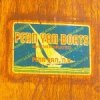Ryan Scott
Curious about Wooden Canoes
Benson and Gil thanks for your input so far. Attached are some pics of the screw heads. I found an old article in the forums that had lots of info on these 'Reed and Prince' screws.
Finally got this canoe shipped to the west coast and will be restoring it. We covered this thing in fiberglass as kids in the early 80's. Will be going through the removal process as soon as I can assure of keeping its shape, or adjusting it as Benson pointed out, more rocker than likely built in originally. Over all I am surprised how intact it is. It hasn't been floated in 25 years, just been sitting outside under partial cover, barley off the ground if at all. Sorta glad I thought fiberglass was the way to go back then.
My idea so far is to;
- Clean up the interior -Strip clean ribs/planking of old varnish with heat gun.
treat wood as needed
rebuild decks, inwales
Ribs look good so far
- Strip fiberglass
repair an old repair done with 'wood' of questionable reliability
- Re-canvas
Paddle happily away!!!
That easy...right????
Any and all advice, questions, remarks (smart A or otherwise) greatly looked forward to.
Finally got this canoe shipped to the west coast and will be restoring it. We covered this thing in fiberglass as kids in the early 80's. Will be going through the removal process as soon as I can assure of keeping its shape, or adjusting it as Benson pointed out, more rocker than likely built in originally. Over all I am surprised how intact it is. It hasn't been floated in 25 years, just been sitting outside under partial cover, barley off the ground if at all. Sorta glad I thought fiberglass was the way to go back then.
My idea so far is to;
- Clean up the interior -Strip clean ribs/planking of old varnish with heat gun.
treat wood as needed
rebuild decks, inwales
Ribs look good so far
- Strip fiberglass
repair an old repair done with 'wood' of questionable reliability
- Re-canvas
Paddle happily away!!!
That easy...right????
Any and all advice, questions, remarks (smart A or otherwise) greatly looked forward to.

















